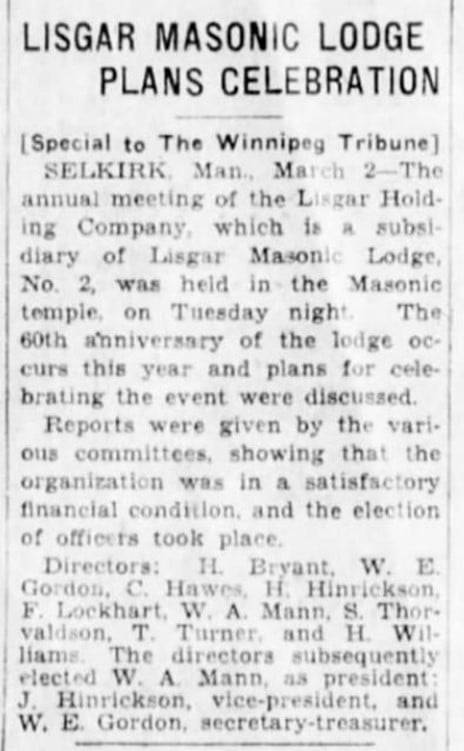209 Eaton Avenue
The Lisgar Masonic Lodge is the second oldest Masonic lodge in Manitoba. It received its dispensation from the Grand Lodge of Canada on January 4, 1871, and its charter was issued on July 13, 1871. When the Manitoba Grand Lodge was established in 1875, Selkirk’s lodge became known as Ligar Lodge No. 2 (The first lodge, Prince Rupert Lodge No. 1, was established on December 10, 1870 in Winnipeg).
Among those who petitioned to create the Lisgar Lodge included John Christian Schultz, Thomas Bunn and William N. Kennedy. Its original officers were John Fraser (Lodge Master), George Black and Thomas Bunn. In its first year, a number of executive members came from established lodges in the surrounding area, such as; W. J. Piton, G. H. Keelong, and M. Lawson from the Prince Rupert Lodge in Winnipeg; and E. Abell from Northern Star Lodge No. 23 in Minnesota.
Different Homes
In nearly 150 years of its existence, Lisgar Lodge has been housed in around ten different locations.
The Lodge’s first two meetings – February and March 1871 – were held at Lower Fort Garry. From April 1871 to July 1873, they met in a room over the store of George Black in Mapleton, St. Andrews.
In the summer of 1873, Bernard Ross built a 35 x 22-foot store at the hamlet of Brookside, St. Andrews. It’s been described as being located half-way between what would later become Lockport and Little Britain Church. The upper floor was used as the Masonic Lodge’s meeting place. Ross died in 1878 and his property was sold off, leaving Lisgar Lodge yet again in search of a new home.
After leaving the building Ross built, Lodge members concentrated their search efforts in Selkirk. They rented the former Weir family home on Eveline Street at Clandeboye Avenue, and their first meeting took place on February 3, 1879. From there, the Lodge moved to rooms over Bullock’s store on Eveline Street, then to rented rooms on Eveline Street over Moody and Sutherland’s hardware store. Around 1899, the lodge moved yet again to the space above McKenzie’s store at the northeast corner of Main Street and Manitoba Avenue.
A local newspaper story from that time notes that new lodge premises were financed by Mrs. L. Moncreiff and dedicated on November 15, 1910, but the exact location is never mentioned.
As the community of Selkirk grew, so did Lisgar Lodge. Its membership swelled from 36 members in 1905, to 154 members in 1924.
207-209 Eaton Avenue
In 1914, the Lodge created a property committee to find a location for what would be its first permanent home. The building itself would be owned by Lisgar Holdings Ltd., a subsidiary of the Lodge.
One source states that the two lots the Lodge currently stands on – 207 and 209 Eaton Avenue – were purchased before the First World War began, but hostilities put the fundraising campaign for its construction on hold.
Fundraising resumed in 1919 under Lodge Master Charles H. Gifford. They broke ground in early August 1920 on the new two-storey, 28 x 50-foot building. It featured a concrete foundation with brick exterior, a decorative cornice, and a pediment above the doorway, which are still on the building today. The architect and contractor was Colin C. McKenzie.
On September 8, 1920 a cornerstone laying ceremony was held and the Lodge opened later in the year.
“A more convenient location,” One newspaper at the time noted, “could not have been selected for the new temple.”
With its proximity to the town hall, Carnegie Library, and Central School, it was also less than a block from the street car line that ran from Winnipeg to Selkirk via Eveline Street.
Powerful Members
The proximity of the lodge to the power centre of Selkirk is indicative of the power that the Masonic Lodge once held in the community. Early Masons included businessmen such as R. H. Gilhuly, James Colceugh, and R. C. Moody, who all served as Lodge Master in the late 1800s.
There was also Captain Charles Henry West (who was in charge of dredging the Red River for nearly two decades), Dr. David Young (first superintendent of the Manitoba Asylum), R. W. Stewart (editor and publisher of the Selkirk Record newspaper for nearly 50 years starting in 1885), James Dagg (a long-time councillor and mayor), and Sir Sam Benfield Steele of the Royal Northwest Mounted Police.
As powerful as the Masonic Lodge was, the fundraising campaign for the building fell short, and Lisgar Holdings had to take out a mortgage. It was finally paid off in 1945.
The upstairs hall, with a capacity 64, could also be rented for public functions. Over the decades, hundreds of banquets, music recitals, teas, and speeches would be held there.

Recent Years
Lisgar Lodge hosted a picnic in Selkirk Rotary Park on July 3rd, 1971 to celebrate its 100th anniversary.

Over the summer of 1977, the building’s interior was extensively renovated. It reopened with a public open house on September 17th of the same year.
In more recent years, the building had also been home to the Khartum Carvers, Prince of Wales Chapter of the Royal Arch Masons, and the Selkirk Shrine Circus Club.
In 2016, the building was put up for sale and it was vacated in 2017. In 2018, it was sold to a developer who turned it into four residential suites.
Lisgar Lodge No. 2 – seemingly always in search of a new home – now meets at Little Britain Church Hall in Lockport, Manitoba.
Masonic Lodge Collection
Sources
Arborg Lake Centre News, 1971
Freemasonry in Manitoba 1864-1925 by Douglas, William
Manitoba Free Press, 1875, 1885, 1920
Proceedings of the Grand Lodge of Manitoba, Ancient, Free and Accepted Masons
by Freemasons Grand Lodge of Manitoba
Selkirk Enterprise, 1944, 1965, 1971, 1974, 1977
The Builder Magazine, 1924
Winnipeg Free Press, 1895, 1922
Winnipeg Tribune, 1910, 1931

















